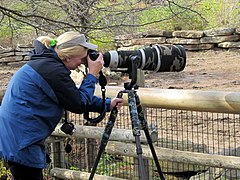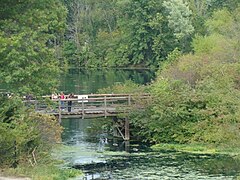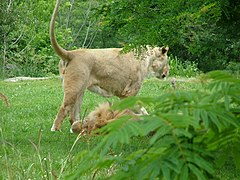Kansas City Zoo & Aquarium
| Kansas City Zoo & Aquarium | |
|---|---|
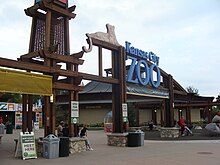 | |
 | |
| 39°0′25″N 94°31′45″W / 39.00694°N 94.52917°W | |
| Date opened | December 13, 1909 |
| Location | Swope Park Kansas City, Missouri, United States |
| Land area | 202 acres (82 ha)[1] |
| No. of animals | 1,700+ (Zoo)[1] and 8,000+ (Aquarium)[2] |
| Annual visitors | 1+ million[3] |
| Memberships | AZA[4] |
| Website | https://kansascityzoo.org |
The Kansas City Zoo & Aquarium is a 202-acre (82 ha) zoo founded in 1909 and is located in Swope Park at 6800 Zoo Drive, Kansas City, Missouri, in the United States. The zoo has a Friends of the Zoo program to help promote the work of the zoo which sees over one million visitors a year. The zoo is home to nearly 1,700 animals and the aquarium has around 8,000 animals. The zoo is an accredited member of the Association of Zoos and Aquariums (AZA).
History
Planning for the zoo started in 1907, and its gates opened on December 13, 1909. The zoo evolved slowly during its first 40 years, while it added exhibits such as the Bear Grotto in 1912. It gained more momentum when it added a monkey island and a children's zoo in the 1940s. In the 1950s, the sea lion pool, African Veldt, giraffe house and flamingoes were all added; and the zoo added an otter pool, elephant house, and the Great Ape House in the 1960s. The early 1970s brought a dairy barn, the Great Catwalk and gibbon islands. Approximately twenty years later (in 1991), after voting and finances from a grant, the zoo expanded to the current size of 202 acres (82 ha), adding Australia in 1993, International Festival in 1994, and Africa in 1995. The opening of the Africa section drew in approximately 40,000 visitors in first 2 days.
The zoo would also build a new building to feature the first IMAX in a zoo, the Sprint IMAX Theater. The improvements resulted in record attendance of 700,000 zoo guests and 400,000 IMAX visitors in 1998. The zoo has grown from a small building and 60 acres (24 ha) to a large, 202-acre (82 ha) zoo with over 1,300 animals. The Orangutan Primadome opened in 2002 as a part of new management when the zoo changed from a city-operated organization to a public-private partnership with Friends of the Zoo (FOTZ for short).
A 20-year plan plots the zoo's future, including new improvements. The Discovery Barn opened in 2006 along with a short-cut path to Africa. In 2006, the Kansas City Zoo was selected to become a breeding facility for African elephants and baboons[by whom?]. In 2007, an endangered species carousel was added to KidZone. The Zoo closed the Sprint IMAX Theater on September 4, 2007.[5] New admission gates to the zoo were opened in May 2008 featuring new parking and animals.
Extensive renovations of the zoo began in late 2005.[6] The Discovery Barn opened in 2006, formerly the Red Barn. It contains many exhibits and slides for children. Outside, there is a Peek-a-Boo Tree, that is fun for children to play in and get a sky-high view at the top of the tree, and like the Discovery Barn, it also contains a slide. The Promenade was also added in 2006, which is a wide path straight to the African elephants exhibit, which allows guests to reach Africa much faster. The new entrance admission gates opened in May 2008, with an educational center and a North American river otter and trumpeter swan exhibits. In early 2009, the Tropics House opened behind the Sea Lion pavilion in the 1909 Building and the polar bear exhibit opened in August 2010, located near the entrance, in the location formerly occupied by stroller rental.[7] In October 2013, the Helzberg Penguin Plaza opened, funded by an ongoing series of fundraising events as well as a 1/8th cent sales tax collected from the 2 county Zoological District.[8] In 2023 the $77 million Sobela Ocean Aquarium, which involved over 10 years of planning, opened to the public.[2]
Exhibits
The zoo is 202 acres (82 ha) and is home to more than 1,300 animals. It is located in Swope Park, the 29th largest municipal park in the United States. The zoo is divided into five areas of the following themes: Africa, Australia, Tiger Trail, KidZone and The Valley.
Front entry plaza
The admission gates and facilities (such as restrooms, gift shop, and food) are located in the entrance to the Kansas City Zoo. In 2010,
Polar Bear Passage

This exhibit opened on August 8, 2010, with the introduction of a polar bear named Nikita,
Africa
The Africa section is broken up into five subsections: Botswana, Kenya, Tanzania, the Congolese Rainforest, and Uganda. Several snack bars are located throughout Africa, as well as the Rafiki Restaurant and Equator gift shop in the Nanyuki Market (Kenya). Nanyuki Market also has a small aviary for
Botswana
Botswana contains nine
A male African elephant, Tamani from
All 9 elephants at the zoo, and their origins, are as follows:
Christi (b. 1986, wild-born in Africa) from Hogle Zoo
Lady (b. 1968, wild-born in Africa) from Kings Island
Lea (b. 1978, wild-born in Zimbabwe)
Lois (b. 1978, wild-born in Zimbabwe)
Megan (b. 1978, wild-born in Kruger National Park, South Africa) from Kings Island
Tamani (b. 2005, at
Tattoo (b. 1978, wild-born in Africa) from Riverbanks Zoo
Zoe (b. 1984, wild-born in Africa) from Cameron Park Zoo
Zuri (b. 2009, at Hogle Zoo) from Hogle Zoo
Kenya
Kenya has
Tanzania

Tanzania features an
pool.Uganda
Uganda section has a small outdoor theater stage (Ruwenzori Theatre), and is home to spacious enclosures with African wild dogs and a troop of Guinea baboons, which sit adjacent to one another. A reservation-only campsite is located off into the woods from Uganda.
The Congolese Rainforest
The Congolese Rainforest is located across a historic swinging bridge from Kenya. Animals on exhibit include
Australia

Australia lies in the northernmost part of the zoo; there you can find a large field that is home to free-roaming
It was announced in 2015 that the zoo would welcome a pair of koalas as a featured attraction in the summer of 2016.[11]
Tiger Trail
The Tiger Trail has been home to many types of animals over the years; and recently, the area was renovated to center around the return of tigers to the Kansas City Zoo and its native Asia. The region of the zoo features oriental plants, lanterns, statues and various pictures of Asian animals. The
Orangutan Canopy
After moving from the outdated
KidZone

The KidZone area features a large cage for rainbow lorikeets, with three daily feedings that guests may participate in. There is a large sea lion pool, which has several shows daily. The original 1909 building is located behind the sea lions, which has seen many renovations over the years and was most recently reopened in early 2009 as the Tropics House.
Discovery Barn
In the Discovery Barn, scarlet macaw, green-winged macaw, White's tree frog, hourglass tree frog, squirrel monkey, marine toad, American toad, radiated tortoise, Prevost's squirrel, Linne's two-toed sloth, ring-tailed lemur, and poison dart frog are housed alongside educational and fun features for children, including slides.
Tropics

Tropics is housed in the zoo's original building. The structure opened in summer 1909 and it was built at a cost of $32,000. It housed the zoo's entire collection. Originally known as the "Bird and Carnivora House", it featured a gabled roof heavily ornamented with architectural terra cotta and a large arching window. The gabled ends and eaves featured decorative carved stone bird heads – kingfishers, owls, and parrots. The original roof was removed in 1969 due to the badly deteriorating wooden framing. The building was closed in the 1990s, before reopening after a minor renovation in 2002. The building, used at that time for a traveling reptile exhibit, closed again in 2004 before undergoing much more extensive renovations. Following extensive renovation, the building reopened as Tropics in May 2009.[18]
In the Tropics House,
Helzberg Penguin Plaza

The Helzberg Penguin Plaza opened on October 25, 2013. The 19,000 square feet (1,800 m2) facility features a 100,000 US gallons (379,000 L) cold water tank built for cold water penguins and a 25,000 US gallons (95,000 L) pool for warm weather penguins. Four species of penguins — king, gentoo, rockhopper, and Humboldt — are housed in the building alongside smaller aquarium exhibits featuring fish, jelly fish, and a coral reef display.
The Valley
The Valley area of the zoo opened in 1912, and it served as a primary portion of the zoo for many years. The first exhibits were a bear pit and a duck pond on the east side of the Valley. In 1914, a grizzly bear named Nemo was brought to the zoo from Yellowstone National Park. Nemo escaped from his enclosure in the Valley after bending the bars around his exhibit and scaling the rock bluff. The bear was eventually found 18 days later in a pool at a local cemetery.[20]
In 1932, the
Monkey Island was the centerpiece of the Valley. The island was surrounded by a moat 20 feet (6.1 m) wide and 6 feet (1.8 m) deep. The Monkey Island exhibit opened in June 1946 with
Most of the Valley was closed in 2002 and it was entirely closed by 2005. A
Great Ape House

The zoo's former Great Ape House was a distinctive architectural landmark in Kansas City since it was completed in 1966. At the time of its construction, it was heralded as a modern marvel. The Great Ape house's distinctive mid-century design had been compared to structures in Disney's Tomorrowland, as well as the Liverpool Metropolitan Cathedral. In its earlier years, the ape house served as a central identity for the zoo, appearing on postcards and numerous zoo souvenirs.[21][22][23][24] At the time it was opened, the 55 feet (17 m) tall circular building was home to seven gibbons, five chimpanzees, two orangutans and two gorillas.
Eventually the apes were all relocated to different areas of the zoo with only orangutans remaining in the exhibit by the time it was closed in 2003, with the opening of their new enclosure in Tiger Trail. Following its closure, supporters have pushed for its redevelopment for other uses due to its iconic architectural significance as a recognizable landmark. Discussion of the ape house's demolition began as early as 2001; however, the possibility of redevelopment has emerged as support for the zoo has increased dramatically since then. While it was still in operation, former zoo director Ernest Hagler suggested moving out the animals and turning the building into a gift shop or restaurant. It was never re-purposed and after sitting empty for over a decade, the building was ultimately demolished in September 2015, to make room for a new addition to the zoo, tentatively titled Predator Canyon.[25] As of 2023, the former site has been converted to the Outback Campground, which can be reserved for overnight events.[26]
Transportation
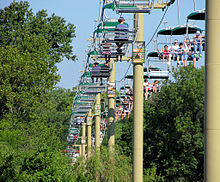
- Zebra Trams
A zebra-themed tram takes zoo guests along the
- Kansas City Zoo Railroad
A mini train takes visitors around the main area of the zoo with stops at World Gate and Australia.
- Kenyan Cruise Boat Ride
A boat takes visitors (Memorial Day through Labor Day) for an up-close view of the African savannah animals, such as the
- African Sky Safari
A modified ski lift that goes over the middle of the Africa section from the marketplace to the chimpanzees. Riders may choose to ride a round-trip or get off on the other side. The Sky Safari opened to the public in the summer of 2011.[27]
Gallery
-
Professional photographer taking nature photos at the zoo.
-
Superb starling (Lamprotornis superbus).
-
Rhinoceros.
-
Inside the Tropics exhibit.
-
Blue monkey with newborn child in the Tropics exhibit.
-
Bridge walkway in one of the nature settings.
-
Hippopotamus.
-
Otter exhibit.
-
Lion and lioness at the zoo.
-
Carousel at the zoo.
Escapes
On February 19, 2012, two adult gorillas escaped from their enclosure when their door was accidentally left open. The gorillas were quickly captured after they wandered around the building they were housed in for a few minutes and no one was injured or threatened.[28]
On April 10, 2014, seven chimpanzees escaped from their enclosure when one of the animals used a log to scale the wall. The zoo was put on lockdown and visitors were kept safe inside designated buildings throughout the zoo until all seven chimpanzees had been returned to their exhibit.[29]
On May 29, 2019, an elephant escaped its enclosure after scaling a wall. It was returned to its enclosure safely within an hour.[30]
References
- ^ a b c Merlin, Lalla. "Kansas City Zoo: transformation into a modern, conservation-focused attraction". Blooloop.
- ^ a b Ljungblad, Tammy. "Take a look inside the Sobela Ocean Aquarium, KC Zoo's new 'jewel' opening soon". McClatchy Media Network. The Kansas City Star.
- ^ Bush, Jared. "Kansas City Zoo to award their millionth visitor of the year". Nexstar Media Inc. FOX 4.
- ^ "Currently Accredited Zoos and Aquariums". aza.org. AZA. Retrieved 26 June 2011.
- ^ Kansas City Zoo Press Release, "Kansas City Zoo Sprint IMAX© Theatre Closes September 4," August 28, 2007
- ^ Kansas City Zoo Press Release, "Zoo Launches Most Aggressive Renovation in 10 Years," August 10, 2007
- ^ Kansas City Star, June 10, 2008 [dead link]
- ^ Kansas City Zoo Marketing Department [when?]
- ^ Kansas City Zoo Press Release, "A Big Celebrity Is Coming to Town," March 9, 2010
- ^ nncnow, "Berlin the Polar Bear on Exhibit in Kansas City Zoo" Archived 2013-04-10 at the Wayback Machine, 2013 January 17
- ^ a b Matt Campbell (June 24, 2015). "Kansas City Zoo is losing its male polar bear, Nikita". Kansas City Star. Archived from the original on 2016-04-04. Retrieved March 27, 2016.
- ^ KMBC 9 News Staff (November 12, 2020). "Meet Nuniq! New male polar bear unveiled at Kansas City Zoo". KMBC Channel 9. Archived from the original on 2020-12-02. Retrieved June 6, 2021.
{{cite web}}: CS1 maint: numeric names: authors list (link) - ^ "Kansas City Zoo welcomes 9-year-old Tamani". 5 October 2015. Archived from the original on 2015-10-07. Retrieved 2015-10-14.
- ^ "Elephant Updates".
- ^ a b Kansas City Zoo [when?]
- ^ "Orangutan Canopy Ground Breaking | Kansas City Zoo". Archived from the original on 2015-09-28. Retrieved 2015-09-27.
- ^ "New 'Orangutan Canopy' exhibit now open at the Kansas City Zoo | the Kansas City Star". Archived from the original on 2015-09-30. Retrieved 2015-09-27.
- ^ "Taylor Kelly Renovates Kansas City Zoo's Original Main Building". Modern Builder. May–June 2009. pp1-2.
- ^ KCTV5 News, July 2, 2008 Archived May 19, 2011, at the Wayback Machine
- ^ a b c "Down in the Valley". Kansas City Zoo Expeditions. Winter 2013. pp14-16
- ^ kawsmouth.com, "Palace of the Apes" Archived 2014-09-03 at the Wayback Machine, Lucas Wetzel, 2012 June 30
- ^ Ljungblad, Tammy. "With KC Zoo's famed Great Ape House doomed, its remaining residents will soon leave view too." Kansas City Star. March 7, 2001. A1
- ^ Hancocks, David. Animals and architecture. 1971. p 144.
- ^ Seeliger, Ruth. Kansas City Zoo Tales: A Wild 100-Year History. 1999
- ^ "Once iconic Great Ape House torn down at the Kansas City Zoo | the Kansas City Star". Archived from the original on 2015-09-26. Retrieved 2015-09-27.
- ^ "Camp Out at the Zoo". Kansas City Zoo. Retrieved 2 June 2023.
- ^ "Kansas City Zoo: African Sky Safari". 17 June 2011. Archived from the original on 2017-04-09. Retrieved 2017-04-08.
- Kansas City Star. Archivedfrom the original on 2012-02-23. Retrieved 2012-03-06.
- Kansas City Star. Archivedfrom the original on 2015-01-09. Retrieved 2014-08-31.
- ^ Bill Smith (May 29, 2019). "'All clear' at the Kansas City Zoo after 'active code red' situation with elephant". KCTV5 News. Retrieved May 31, 2019.
Further reading
- Seeliger, Ruth. Kansas City Zoo Tales: A Wild 100-Year History. Kansas City, Mo.: Kansas City Star Books. OCLC 491447577.

